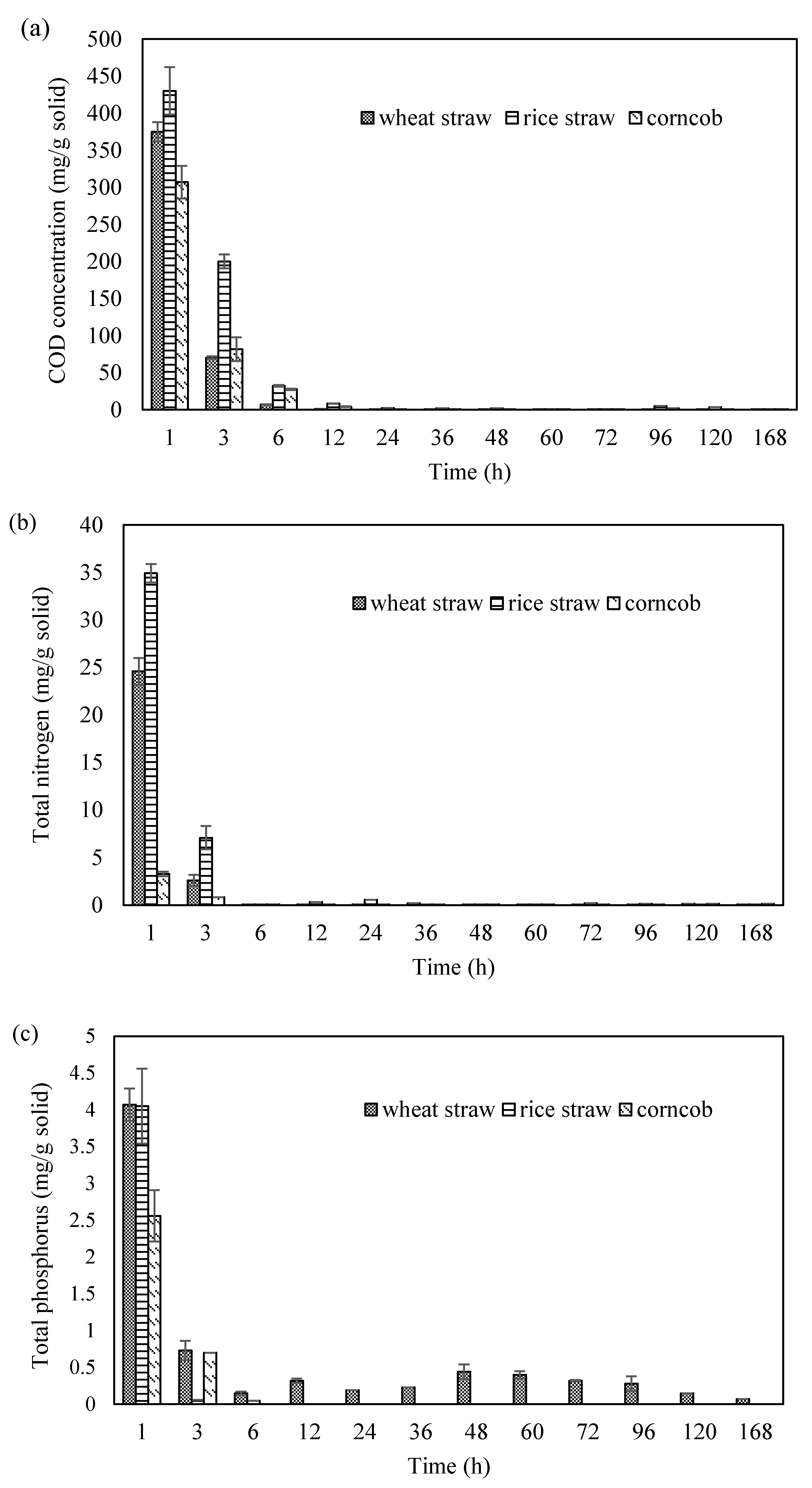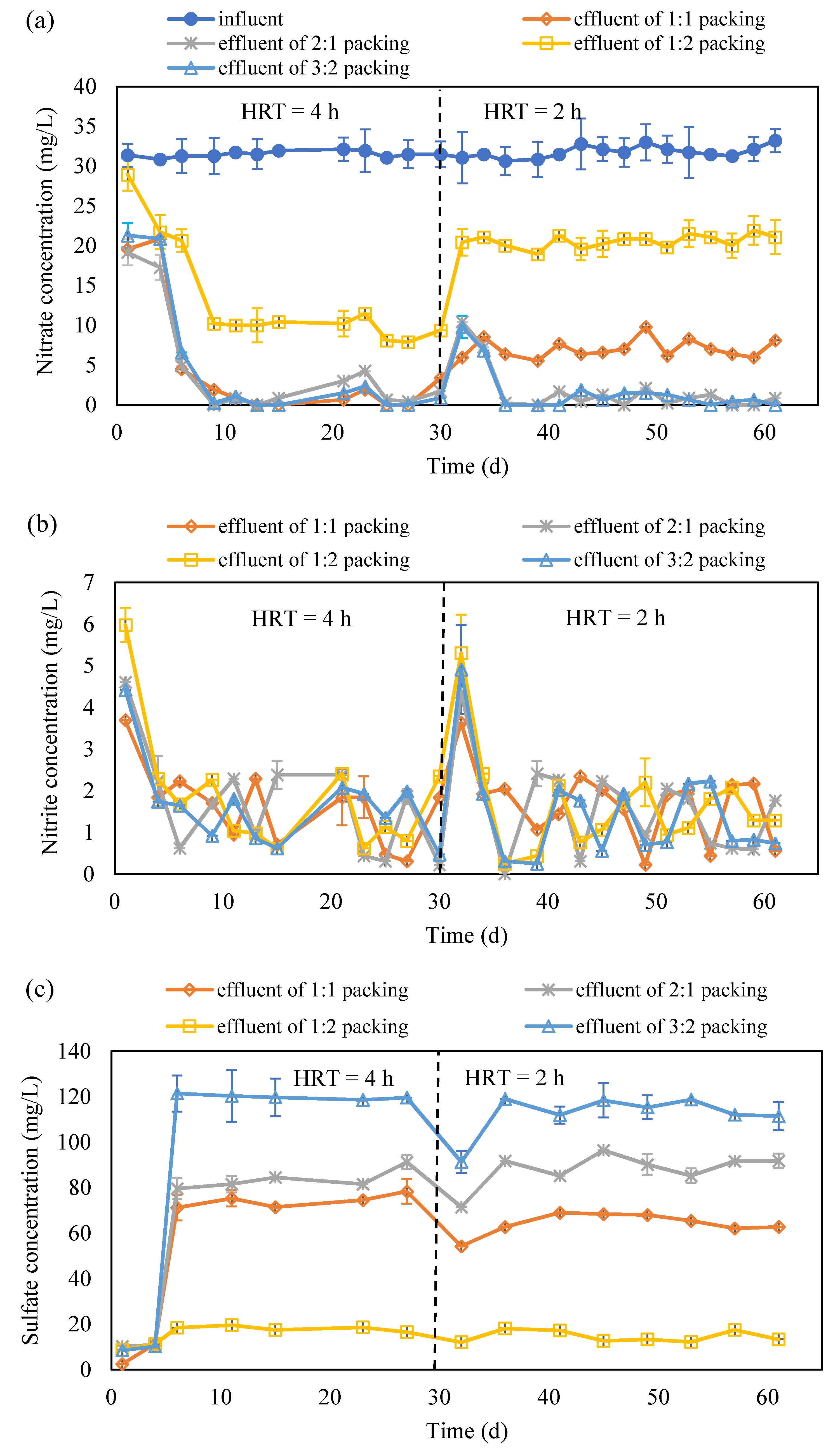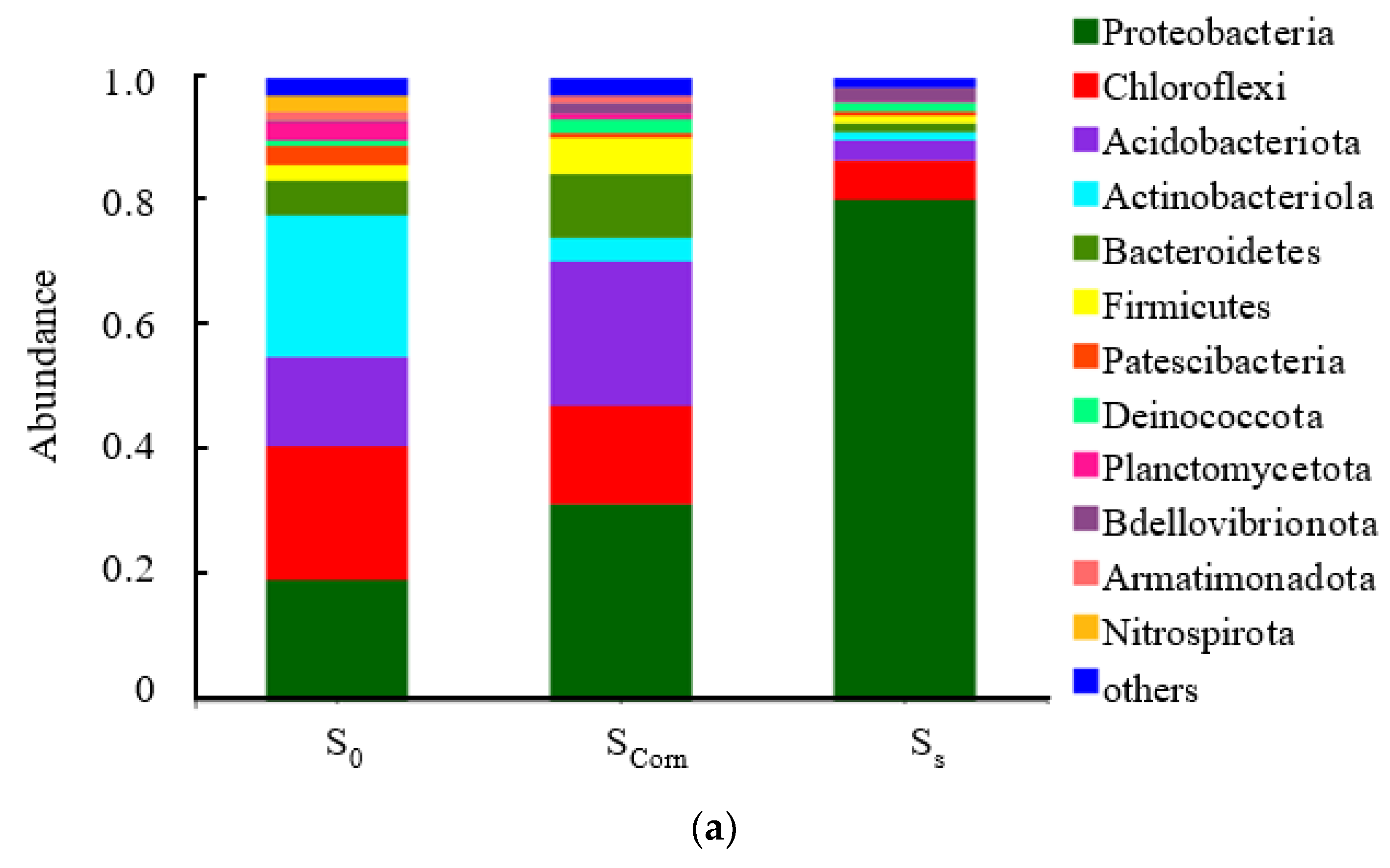Agriculture Waste as Slow Carbon Releasing Source of Mixotrophic Denitrification Process for Treating Low C/N Wastewater
Abstract
:1. Introduction
2. Materials and Methodology
2.1. Materials
2.2. The Carbon Release Column Experiment
2.3. The Denitrification Experiment
2.3.1. Heterotrophic Denitrification
2.3.2. Mixotrophic Denitrification
2.4. The Analytic Methods
3. Results and Discussion
3.1. The Carbon and Nutrient Release from Solid Carbon Source
3.2. The Denitrification Performance of the Solid Carbon Source
3.3. The Mixotrophic Denitrification
3.3.1. The Mixed Corncob and S0 for Mixotrophic Denitrification
3.3.2. The Separated Corncob and S0 for Mixotrophic Denitrification
3.4. The Microorganism in the Denitrification
4. Conclusions
Supplementary Materials
Author Contributions
Funding
Institutional Review Board Statement
Informed Consent Statement
Data Availability Statement
Conflicts of Interest
References
- Mishra, S.; Singh, V.; Cheng, L.; Hussain, A.; Ormeci, B. Nitrogen removal from wastewater: A comprehensive review of biological nitrogen removal processes, critical operation parameters and bioreactor design. J. Environ. Chem. Eng. 2022, 10, 107387. [Google Scholar] [CrossRef]
- Chang, M.; Liang, B.; Zhang, K.; Wang, Y.; Jin, D.; Zhang, Q.; Hao, L.; Zhu, T. Simultaneous shortcut nitrification and denitrification in a hybrid membrane aerated biofilms reactor (H-MBfR) for nitrogen removal from low COD/N wastewater. Water Res. 2022, 211, 118027. [Google Scholar] [CrossRef] [PubMed]
- Zou, L.; Zhou, M.; Luo, Z.; Zhang, H.; Yang, Z.; Cheng, H.; Li, R.; He, Q.; Ai, H. Selection and synthesization of multi–carbon source composites to enhance simultaneous nitrification–denitrification in treating low C/N wastewater. Chemosphere 2022, 288, 132567. [Google Scholar] [CrossRef] [PubMed]
- Sahinkaya, E.; Dursun, N.; Kilic, A.; Demirel, S.; Uyanik, S.; Cinar, O. Simultaneous heterotrophic and sulfur-oxidizing autotrophic denitrification process for drinking water treatment: Control of sulfate production. Water Res. 2011, 45, 6661–6667. [Google Scholar] [CrossRef]
- Sun, S.; Liu, J.; Zhang, M.; He, S. Thiosulfate-driven autotrophic and mixotrophic denitrification processes for secondary effluent treatment: Reducing sulfate production and nitrous oxide emission. Bioresour. Technol. 2020, 300, 122651. [Google Scholar] [CrossRef]
- Chu, Y.; Liu, W.; Tan, Q.; Yang, L.; Chen, J.; Ma, L.; Zhang, Y.; Wu, Z.; He, F. Vertical-flow constructed wetland based on pyrite intensification: Mixotrophic denitrification performance and mechanism. Bioresour. Technol. 2022, 347, 126710. [Google Scholar] [CrossRef]
- Liu, Q.; Huang, C.; Chen, X.; Wu, Y.; Lv, S.; Wang, A. Succession of functional bacteria in a denitrification desulphurisation system under mixotrophic conditions. Environ. Res. 2020, 188, 109708. [Google Scholar] [CrossRef]
- Huang, C.; Liu, Q.; Li, Z.-L.; Ma, X.-D.; Hou, Y.-N.; Ren, N.-Q.; Wang, A.-J. Relationship between functional bacteria in a denitrification desulfurization system under autotrophic, heterotrophic, and mixotrophic conditions. Water Res. 2021, 188, 116526. [Google Scholar] [CrossRef]
- Li, Y.; Liu, L.; Wang, H. Mixotrophic denitrification for enhancing nitrogen removal of municipal tailwater: Contribution of heterotrophic/sulfur autotrophic denitrification and bacterial community. Sci. Total Environ. 2022, 814, 151940. [Google Scholar] [CrossRef]
- Ai, T.; Zhan, H.; Zou, L.; Fu, J.; Fu, Q.; He, Q.; Ai, H. Potential applications of endogenous sulfide for enhanced denitrification of low C/N domestic wastewater in anodic mixotrophic denitrification microbial fuel cell: The mechanism of electrons transfer and microbial community. Sci. Total Environ. 2020, 722, 137830. [Google Scholar] [CrossRef]
- Zhang, L.; Zhang, C.; Hu, C.; Liu, H.; Bai, Y.; Qu, J. Sulfur-based mixotrophic denitrification corresponding to different electron donors and microbial profiling in anoxic fluidized-bed membrane bioreactors. Water Res. 2015, 85, 422–431. [Google Scholar] [CrossRef] [PubMed]
- Peng, C.; Huang, H.; Gao, Y.; Fan, X.; Peng, P.; Zhang, X.; Ren, H. A novel start-up strategy for mixotrophic denitrification biofilters by rhamnolipid and its performance on denitrification of low C/N wastewater. Chemosphere 2020, 239, 124726. [Google Scholar] [CrossRef]
- Ji, C.; Meng, L.; Wang, H. Enhanced reductive dechlorination of 1,1,1-trichloroethane using zero-valent iron-biochar-carrageenan microspheres: Preparation and microcosm study. Environ. Sci. Pollut. Res. 2019, 26, 30584–30595. [Google Scholar] [CrossRef] [PubMed]
- Xiong, R.; Yu, X.; Zhang, Y.; Peng, Z.; Yu, L.; Cheng, L.; Li, T. Comparison of agricultural wastes and synthetic macromolecules as solid carbon source in treating low carbon nitrogen wastewater. Sci. Total Environ. 2020, 739, 139885. [Google Scholar] [CrossRef] [PubMed]
- Tang, L.; Li, J.; Li, Y.; Zhang, X.; Shi, X. Mixotrophic denitrification processes based on composite filler for low carbon/nitrogen wastewater treatment. Chemosphere 2022, 286, 131781. [Google Scholar] [CrossRef]
- Yang, M.; Wang, X.; Liu, S.; Wu, C.; Wang, Q. Carbon release behaviour of polylactic acid/starch-based solid carbon and its influence on biodenitrification. Biochem. Eng. J. 2020, 155, 107468. [Google Scholar] [CrossRef]
- Zhang, S.; Xiao, L.; Tang, Z.; Zhang, X.; Wang, Z. Microbial explanation to performance stratification along up-flow solid-phase denitrification column packed with polycaprolactone. Bioresour. Technol. 2022, 343, 126066. [Google Scholar] [CrossRef] [PubMed]
- Sun, H.; Wang, E.; Li, X.; Cui, X.; Guo, J.; Dong, R. Potential biomethane production from crop residues in China: Contributions to carbon neutrality. Renew. Sustain. Energy Rev. 2021, 148, 111360. [Google Scholar] [CrossRef]
- Chen, Y.; Zhang, J.; Guo, Z.; Li, M.; Wu, H. Optimizing agricultural biomass application to enhance nitrogen removal in vertical flow constructed wetlands for treating low-carbon wastewater. Environ. Res. 2022, 209, 112867. [Google Scholar] [CrossRef]
- Wang, Z.; Zheng, M.; He, C.; Hu, Z.; Yu, Y.; Wang, W. Enhanced treatment of low-temperature and low carbon/nitrogen ratio wastewater by corncob-based fixed bed bioreactor coupled sequencing batch reactor. Bioresour. Technol. 2022, 351, 126975. [Google Scholar] [CrossRef]
- Wang, X.; Xing, L.; Qiu, T.; Han, M. Simultaneous removal of nitrate and pentachlorophenol from simulated groundwater using a biodenitrification reactor packed with corncob. Environ. Sci. Pollut. Res. 2013, 20, 2236–2243. [Google Scholar] [CrossRef] [PubMed]
- Shen, Q.; Wei, J.; Jiang, L.; Zhang, Q.; Mao, Y.; Liu, C.; Liao, Y.; Ji, F. Denitrification performance and characteristics of untreated corncob for enhanced nitrogen removal of municipal sewage with low C/N ratio. Environ. Res. 2022, 213, 113673. [Google Scholar] [CrossRef]
- Liu, J.; Fu, X.; Yuan, R.; Chen, Z.; Zhou, B.; Chen, H. Carbon sources derived from corncobs enhanced nitrogen removal in SBBR treating low C/N domestic sewage. Process Saf. Environ. Prot. 2022, 166, 628–637. [Google Scholar] [CrossRef]
- APHA (American Public Health Association). Standard Methods for the Examination of Water and Wastewater, 21st ed.; American Public Health Association: Washington, DC, USA, 2005. [Google Scholar]
- Peng, L.; Ma, R.; Jiang, S.; Luo, W.; Li, Y.; Wang, G.; Xu, Z.; Wang, Y.; Qi, C.; Li, Y.; et al. Co-composting of kitchen waste with agriculture and forestry residues and characteristics of compost with different particle size: An industrial scale case study. Waste Manag. 2022, 149, 313–322. [Google Scholar] [CrossRef] [PubMed]
- Rowan, M.; Umenweke, G.C.; Epelle, E.I.; Afolabi, I.C.; Okoye, P.U.; Gunes, B.; Okolie, J.A. Anaerobic co-digestion of food waste and agricultural residues: An overview of feedstock properties and the impact of biochar addition. Digit. Chem. Eng. 2022, 4, 100046. [Google Scholar] [CrossRef]
- Rahimi, Z.; Anand, A.; Gautam, S. An overview on thermochemical conversion and potential evaluation of biofuels derived from agricultural wastes. Energy Nexus 2022, 7, 100125. [Google Scholar] [CrossRef]
- Li, T.; Gao, Y.; Tang, Y.; Xu, Y.; Ren, H.; Huang, H. A new LDH based sustained-release carbon source filter media to achieve advanced denitrogenation of low C/N wastewater at low temperature. Sci. Total Environ. 2022, 838, 156488. [Google Scholar] [CrossRef] [PubMed]
- Ye, L.; Shao, M.-F.; Zhang, T.; Tong, A.H.Y.; Lok, S. Analysis of the bacterial community in a laboratory-scale nitrification reactor and a wastewater treatment plant by 454-pyrosequencing. Water Res. 2011, 45, 4390–4398. [Google Scholar] [CrossRef] [PubMed]
- Kostrytsia, A.; Papirio, S.; Morrison, L.; Ijaz, U.Z.; Collins, G.; Lens, P.N.L.; Esposito, G. Biokinetics of microbial consortia using biogenic sulfur as a novel electron donor for sustainable denitrification. Bioresour. Technol. 2018, 270, 359–367. [Google Scholar] [CrossRef]
- Xing, W.; Li, D.; Li, J.; Hu, Q.; Deng, S. Nitrate removal and microbial analysis by combined micro-electrolysis and autotrophic denitrification. Bioresour. Technol. 2016, 211, 240–247. [Google Scholar] [CrossRef] [PubMed]
- Nisola, G.M.; Redillas, M.C.F.R.; Cho, E.; Han, M.; Yoo, N.; Chung, W.-J. Comparison of reactive porous media for sulfur-oxidizing denitrification of high nitrate strength wastewater. Biochem. Eng. J. 2011, 58–59, 79–86. [Google Scholar] [CrossRef]
- Qin, S.; Liu, H.; Meng, Q.; Zhou, Y.; Xu, S.; Lichtfouse, E.; Chen, Z. Enhanced nutrient removal from mixed black water by a microbial ultra-low weak electrical stimulated anaerobic-two stage anoxic/aerobic process. Chem. Eng. J. 2022, 434, 134615. [Google Scholar] [CrossRef]
- Zhao, J.; Feng, L.; Dai, J.; Yang, G.; Mu, J. Characteristics of nitrogen removal and microbial community in biofilm system via combination of pretreated lignocellulosic carriers and various conventional fillers. Biodegradation 2017, 28, 337–349. [Google Scholar] [CrossRef] [PubMed]








Publisher’s Note: MDPI stays neutral with regard to jurisdictional claims in published maps and institutional affiliations. |
© 2022 by the authors. Licensee MDPI, Basel, Switzerland. This article is an open access article distributed under the terms and conditions of the Creative Commons Attribution (CC BY) license (https://creativecommons.org/licenses/by/4.0/).
Share and Cite
Hong, X.; Tang, L.; Feng, H.; Zhang, X.; Hu, X. Agriculture Waste as Slow Carbon Releasing Source of Mixotrophic Denitrification Process for Treating Low C/N Wastewater. Separations 2022, 9, 323. https://doi.org/10.3390/separations9100323
Hong X, Tang L, Feng H, Zhang X, Hu X. Agriculture Waste as Slow Carbon Releasing Source of Mixotrophic Denitrification Process for Treating Low C/N Wastewater. Separations. 2022; 9(10):323. https://doi.org/10.3390/separations9100323
Chicago/Turabian StyleHong, Xiaohong, Liaofan Tang, Haixia Feng, Xiaolei Zhang, and Xianqiong Hu. 2022. "Agriculture Waste as Slow Carbon Releasing Source of Mixotrophic Denitrification Process for Treating Low C/N Wastewater" Separations 9, no. 10: 323. https://doi.org/10.3390/separations9100323






